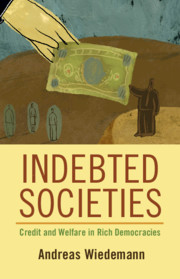Book contents
- Frontmatter
- Contents
- List of Figures
- List of Tables
- Acknowledgments
- 1 Credit and Welfare in Rich Democracies
- 2 A Social Policy Theory of Everyday Borrowing
- 3 Financial Shortfalls and the Role of Welfare States
- 4 Credit Regimes and Patterns of Household Indebtedness
- 5 Borrowing to Address Labor Market Risks
- 6 Borrowing during the Life Course
- 7 The Political and Socioeconomic Consequences of Credit and Debt
- 8 Implications and Conclusion
- Appendix
- Bibliography
- Index
- Series page
6 - Borrowing during the Life Course
Published online by Cambridge University Press: 18 June 2021
- Frontmatter
- Contents
- List of Figures
- List of Tables
- Acknowledgments
- 1 Credit and Welfare in Rich Democracies
- 2 A Social Policy Theory of Everyday Borrowing
- 3 Financial Shortfalls and the Role of Welfare States
- 4 Credit Regimes and Patterns of Household Indebtedness
- 5 Borrowing to Address Labor Market Risks
- 6 Borrowing during the Life Course
- 7 The Political and Socioeconomic Consequences of Credit and Debt
- 8 Implications and Conclusion
- Appendix
- Bibliography
- Index
- Series page
Summary
This chapter focuses on credit as a bounded social investment in light of financial shortfalls that arise during the life course. The Danish welfare state provides strong financial support, particularly for low-income households, through comprehensive family and educational policies such as childcare services and other in-kind benefits that limit families’ financial exposures and lower households’ opportunity costs for taking time off work, sending children to childcare, and pursuing education and training programs. Middle- and high-income households are the ones that draw on credit to smooth income losses when a spouse temporarily leaves work, for example to care for children or to get training. This "investment borrowing" is more prevalent than "consumption borrowing" to cope with labor market-related risks. By contrast, many more American households, including low- and middle-income ones, borrow money to cope with the financial consequence that arise throughout the life course, including income losses due to parental leave or expenses for childcare, education, and training–which would be covered or subsidized by most European welfare states. As life course trajectories have become more fluid and flexible and the traditional single-breadwinner model has declined, Germany’s restrictive credit regime continues to make it hard for households to borrow money.
Keywords
- Type
- Chapter
- Information
- Indebted SocietiesCredit and Welfare in Rich Democracies, pp. 166 - 199Publisher: Cambridge University PressPrint publication year: 2021



